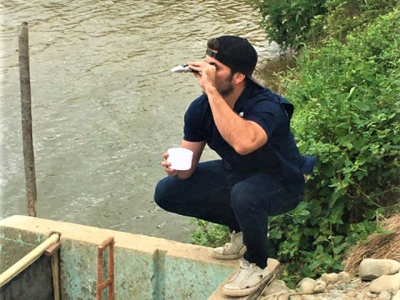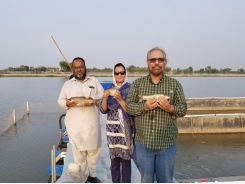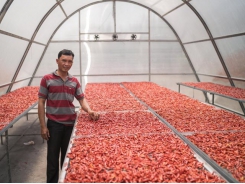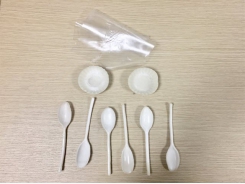Salinity in aquaculture, Part 1

Various definitions describe salinity as an important environmental factor
In aquaculture settings, pond water salinity is routinely measured with a handheld salinity refractometer. Photo by Fernando Huerta.
Those involved in shrimp farming and other kinds of coastal aquaculture recognize salinity as an environmental factor of importance. Most aquaculturists know that salinity represents the total concentration of dissolved salts in water expressed most commonly in parts per thousand (1 ppt = 1 gram/liter = 1,000 mg/liter = 1,000 ppm).
Recently in a manuscript on shrimp farming for a book in the Oxford University Press series on crustaceans, I was instructed to change the use of part per thousand of salinity to practical salinity units. This experience resulted in a quick study of the definition and measurement of salinity according to the oceanographic literature. It was a revelation of how scientists often concern themselves greatly about issues of little or no concern in practical use of scientific concepts.
Various definitions
Salinity is commonly defined as the concentration (g/L or ppt) of dissolved salts. The salinity of seawater was originally defined about 1901 by the Danish scientist Martin Knudsen. The definition was based on the average chlorinity of ocean water, and the following equation applies: Salinity = 0.030 + 1.805 Cl– with Cl– and salinity expressed in g/L. This definition was modified over the years, and in 1967 by international agreement, the Knudsen equation became: Salinity = 1.80655 Cl–.
In 1978, the Joint Panel of Oceanographic Tables and Standards recommended defining salinity in practical salinity units (psu). The psu is a unitless variable. A KCl solution of the same electrical conductivity was found to be 32.4256 g KCl/L distilled water, and waters of the same conductivity were assumed to have the same salinity. Standard seawater (35 ppt) has a conductivity ratio to the KCl standard of 1.00. This relationship can be used to obtain practical salinities of waters of other electrical conductivity values. The difference in common salinity and practical salinity concentrations in most waters will be no more than 0.01 percent.
In 1985, the Intergovernmental Oceanographic Commission of the United Nations Educational, Scientific, and Cultural Organization defined the absolute salinity as the ratio of dissolved salts in seawater to the total mass of seawater (kg dissolved salts/kg seawater). Absolute salinity is very similar to practical salinity in the same water, but slightly less than common salinity. This is because common salinity is reported in g/L, and 1 liter of seawater weighs slightly more than 1 kg upon which practical and absolute salinity concentrations are based. For example, 35 g/kg absolute salinity are at 28 degrees-C is 35.8 g/L common salinity. The important points to note are that after abandoning common salinity, the focus has been on the definition of the salinity of ocean water, and the relationship of electrical conductivity to salinity.
The salinity saga continued and F.J. Millero of the University of Miami and some colleagues developed the reference-composition salinity scale, and it was promptly adopted as the new salinity definition of seawater by the International Oceanographic Commission. The reference composition salinity is difficult to visualize, but it is basically an adjustment of the absolute salinity and is related to practical salinity by the equation: Reference-composition salinity = the practical salinity x 1.004715.
Relevance to aquaculture
Thus, let us look at the salinity definitions as they affect salinity measurements. Common salinity concentrations of 10, 20, 30, 40 ppt were adjusted to other methods of defining and reporting salinity based on the discussion above (Table 1). There does not appear to be appreciable differences. Common salinity and practical salinity are almost identical.
Boyd, salinity, Table 1
| Salinity method | Salinity values | |||
| Common (ppt) | 10 | 20 | 30 | 40 |
| Practical (unitless) | 9.999 | 19.98 | 29.997 | 39.996 |
| Absolute (mg/kg) | 9.96 | 19.78 | 29.46 | 38.98 |
| Reference-composition (mg/kg) | 10.05 | 20.07 | 30.14 | 40.18 |
Table 1. Salinity for waters at different common salinity concentrations versus results for other salinity definitions at 28 degrees-C.
Absolute salinity is a bit lower than common salinity, because the density of water increases with greater salinity (Table 2). The reference-composition salinity is a small amount greater than the common salinity.
Boyd, salinity, Table 2
| Degree Celsius | 10 ppt | 20 ppt | 30 ppt | 40 ppt |
| 10 | 1,007.53 | 1,015.30 | 1,023.08 | 1,030.89 |
| 15 | 1,006.81 | 1,014.47 | 1,022.15 | 1,029.86 |
| 20 | 1,005.82 | 1,013.39 | 1,020.98 | 1,028.61 |
| 25 | 1,004.58 | 1,012.08 | 1,019.60 | 1,027.15 |
| 30 | 1,003.12 | 1,010.55 | 1,018.01 | 1,025.51 |
| 35 | 1,001.46 | 1,008.84 | 1,016.24 | 1,023.69 |
| 40 | 999.60 | 1,006.94 | 1,014.30 | 1,021.70 |
Table 2. Density of water (g/L or kg/m3) at different temperatures and salinities.
As far as aquaculture is concerned, it makes no difference which of these methods of expressing salinity is used. If you do not mind being associated with an old viewpoint on the definition of seawater, oceanographers will no doubt have no concern over you doing so. Of course, the small differences in reporting salinity are likely important to oceanographers in their many models of processes in the ocean, and no criticism of them is intended.
The upshot is that salinity can be measured very easily with a handheld salinity refractometer in the common salinity units of mg/L or ppm, and the resulting values are a close estimate of the salinity (assuming the refractometer is performing correctly). The aquatic organisms in ponds have a tolerance to a range of salinity, and differences in measured and true salinity of tenths of parts per thousand can be tolerated easily.
Related news
Tools

Phối trộn thức ăn chăn nuôi

Pha dung dịch thủy canh

Định mức cho tôm ăn

Phối trộn phân bón NPK

Xác định tỷ lệ tôm sống

Chuyển đổi đơn vị phân bón

Xác định công suất sục khí

Chuyển đổi đơn vị tôm

Tính diện tích nhà kính

Tính thể tích ao




 Microbial activity assessment based on hydrogen peroxide decomposition…
Microbial activity assessment based on hydrogen peroxide decomposition…  HCM City students make biodegradable products from potatoes
HCM City students make biodegradable products from potatoes